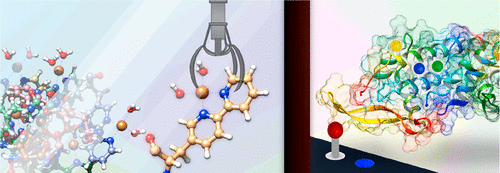当前位置:
X-MOL 学术
›
Acc. Chem. Res.
›
论文详情
Our official English website, www.x-mol.net, welcomes your
feedback! (Note: you will need to create a separate account there.)
Molecular Modeling for Artificial Metalloenzyme Design and Optimization.
Accounts of Chemical Research ( IF 16.4 ) Pub Date : 2020-04-01 , DOI: 10.1021/acs.accounts.0c00031 Lur Alonso-Cotchico 1 , Jaime Rodrı Guez-Guerra 1 , Agustí Lledós 1 , Jean-Didier Maréchal 1
Accounts of Chemical Research ( IF 16.4 ) Pub Date : 2020-04-01 , DOI: 10.1021/acs.accounts.0c00031 Lur Alonso-Cotchico 1 , Jaime Rodrı Guez-Guerra 1 , Agustí Lledós 1 , Jean-Didier Maréchal 1
Affiliation

|
ConspectusArtificial metalloenzymes (ArMs) are obtained by inserting homogeneous catalysts into biological scaffolds and are among the most promising strategies in the quest for new-to-nature biocatalysts. The quality of their design strongly depends on how three partners interact: the biological host, the "artificial cofactor," and the substrate. However, structural characterization of functional artificial metalloenzymes by X-ray or NMR is often partial, elusive, or absent. How the cofactor binds to the protein, how the receptor reorganizes upon the binding of the cofactor and the substrate, and which are the binding mode(s) of the substrate for the reaction to proceed are key questions that are frequently unresolved yet crucial for ArM design. Such questions may eventually be solved by molecular modeling but require a step change beyond the current state-of-the-art methodologies.Here, we summarize our efforts in the study of ArMs, presenting both the development of computational strategies and their application. We first focus on our integrative computational framework that incorporates a variety of methods such as protein-ligand docking, classical molecular dynamics (MD), and pure quantum mechanical (QM) methods, which, when properly combined, are able to depict questions that range from host-cofactor binding predictions to simulations of entire catalytic mechanisms. We also pay particular attention to the protein-ligand docking strategies that we have developed to accurately predict the binding of transition metal-containing molecules to proteins. While this aspect is fundamental to many bioinorganic fields beyond ArMs, it has been disregarded from the molecular modeling landscape until very recently.Next we describe how to apply this computational framework to particular ArMs including systems previously characterized experimentally as well as others where computation served to guide the design. We start with the prediction of the interactions between homogeneous catalysts and biological hosts. Protein-ligand docking is pivotal at that stage, but it needs to be combined with QM/MM or MD approaches when the binding of the cofactor implies significant conformational changes of the protein or involve changes of the electronic state of the metal.Then, we summarize molecular modeling studies aimed at identifying cofactor-substrate arrangements inside the ArM active pocket that are consistent with its reactivity. These calculations stand on "Theozyme"-like dockings, MD-refined or not, which provide molecular rationale of the catalytic profiles of the artificial systems.In the third section, we present case studies to decode the entire catalytic mechanism of two ArMs: (1) an iridium based asymmetric transfer hydrogenase obtained by insertion of Noyori's catalyst into streptavidin and (2) a metallohydrolase achieved by including a receptor. Transition states, second coordination sphere effects, as well as motions of the cofactors are identified as drivers of the enantiomeric profiles.Finally, we report computer-aided designs of ArMs to guide experiments toward chemical and mutational changes that improve their activity and/or enantioselective profiles and expand toward future directions.
中文翻译:

人工金属酶设计和优化的分子模型。
概述人工金属酶(ArMs)是通过将均相催化剂插入生物支架中而获得的,并且是寻求新的生物催化剂的最有希望的策略之一。他们的设计质量在很大程度上取决于三个伙伴如何相互作用:生物宿主,“人工辅因子”和基质。但是,通过X射线或NMR对功能性人工金属酶的结构表征通常是部分,难以捉摸或不存在的。辅因子如何与蛋白质结合,受体如何在辅因子与底物结合后重组,以及底物的结合模式是反应进行的关键问题,这些问题通常尚未解决,但对于ArM而言至关重要设计。这些问题最终可能会通过分子建模解决,但需要在当前的最新方法学之上进行一步改变。在此,我们总结了在ArMs研究中所做的努力,同时介绍了计算策略的发展及其应用。我们首先关注我们的综合计算框架,该框架结合了多种方法,例如蛋白质-配体对接,经典分子动力学(MD)和纯量子力学(QM)方法,这些方法经过适当组合后能够描述范围广泛的问题从宿主辅因子结合预测到整个催化机理的模拟。我们还特别注意了我们开发的蛋白质-配体对接策略,该策略可准确预测含过渡金属的分子与蛋白质的结合。尽管这对于ArMs以外的许多生物无机领域来说都是至关重要的,但直到最近才被分子建模领域所忽略。指导设计。我们从均相催化剂与生物主体之间相互作用的预测开始。蛋白质-配体对接在此阶段至关重要,但是当辅因子的结合暗示蛋白质的构象发生重大变化或涉及金属电子态的变化时,需要将其与QM / MM或MD方法结合使用。我们总结了分子建模研究,旨在确定ArM活性囊内部与其反应性一致的辅因子-底物排列。这些计算基于“ Theozyme”样的对接,是否经过MD精制,这些对接提供了人工系统催化分布的分子原理。在第三部分中,我们通过案例研究来解码两个ArM的整个催化机理:( 1)通过将Noyori的催化剂插入链霉亲和素中获得的铱基不对称转移氢化酶,以及(2)通过包含受体获得的金属水解酶。过渡态,第二个协调域效应以及辅因子的运动被认为是对映异构图谱的驱动力。
更新日期:2020-04-23
中文翻译:

人工金属酶设计和优化的分子模型。
概述人工金属酶(ArMs)是通过将均相催化剂插入生物支架中而获得的,并且是寻求新的生物催化剂的最有希望的策略之一。他们的设计质量在很大程度上取决于三个伙伴如何相互作用:生物宿主,“人工辅因子”和基质。但是,通过X射线或NMR对功能性人工金属酶的结构表征通常是部分,难以捉摸或不存在的。辅因子如何与蛋白质结合,受体如何在辅因子与底物结合后重组,以及底物的结合模式是反应进行的关键问题,这些问题通常尚未解决,但对于ArM而言至关重要设计。这些问题最终可能会通过分子建模解决,但需要在当前的最新方法学之上进行一步改变。在此,我们总结了在ArMs研究中所做的努力,同时介绍了计算策略的发展及其应用。我们首先关注我们的综合计算框架,该框架结合了多种方法,例如蛋白质-配体对接,经典分子动力学(MD)和纯量子力学(QM)方法,这些方法经过适当组合后能够描述范围广泛的问题从宿主辅因子结合预测到整个催化机理的模拟。我们还特别注意了我们开发的蛋白质-配体对接策略,该策略可准确预测含过渡金属的分子与蛋白质的结合。尽管这对于ArMs以外的许多生物无机领域来说都是至关重要的,但直到最近才被分子建模领域所忽略。指导设计。我们从均相催化剂与生物主体之间相互作用的预测开始。蛋白质-配体对接在此阶段至关重要,但是当辅因子的结合暗示蛋白质的构象发生重大变化或涉及金属电子态的变化时,需要将其与QM / MM或MD方法结合使用。我们总结了分子建模研究,旨在确定ArM活性囊内部与其反应性一致的辅因子-底物排列。这些计算基于“ Theozyme”样的对接,是否经过MD精制,这些对接提供了人工系统催化分布的分子原理。在第三部分中,我们通过案例研究来解码两个ArM的整个催化机理:( 1)通过将Noyori的催化剂插入链霉亲和素中获得的铱基不对称转移氢化酶,以及(2)通过包含受体获得的金属水解酶。过渡态,第二个协调域效应以及辅因子的运动被认为是对映异构图谱的驱动力。











































 京公网安备 11010802027423号
京公网安备 11010802027423号